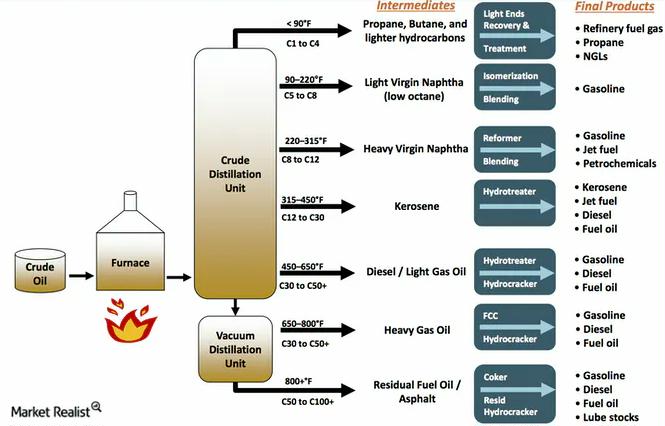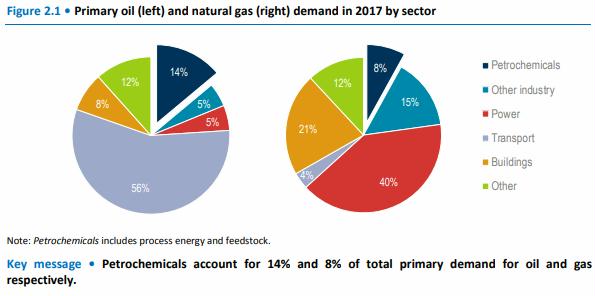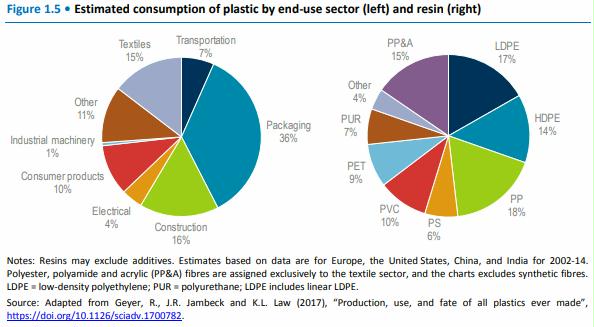
Preface. It is quite likely that after fossils are gone, plastics will no longer be made, since they are incredibly complex – PhDs in numerous fields make them possible – and most kinds have been around for only 50 years or less. Thwaites (2011) showed how hard replicating a complex process that we take for granted would be by performing a simple exercise: He tried to make an ordinary toaster from scratch. Even the simplest toaster had 404 parts of plastic, steel, mica, copper, and nickel. After a great deal of struggle, he was able to make the metal pieces, which mankind has made since the Iron Age. But plastics were beyond him. He’d have had to refine crude oil to make propylene, which takes at least six chemical transformations to make into the simplest plastic, polyethylene.
Crude oil is the feedstock for half a million products. What follows is a description of how plastic is made. My book “Life After Fossil Fuels” discusses plastic in more depth — how much biomass is needed, how to replace asphalt and lubricants, and recycling.
Alice Friedemann www.energyskeptic.com Author of Life After Fossil Fuels: A Reality Check on Alternative Energy; When Trucks Stop Running: Energy and the Future of Transportation”, Barriers to Making Algal Biofuels, & “Crunch! Whole Grain Artisan Chips and Crackers”. Women in ecology Podcasts: WGBH, Crazy Town, Collapse Chronicles, Derrick Jensen, Practical Prepping, Kunstler 253 &278, Peak Prosperity, Index of best energyskeptic posts
***
We consume about ONE BILLION TONS of products a year. We live like kings. Of all the fossil fuels we use in a year, about seven percent – 500 million metric tons of oil equivalent, the weight of all the people on earth – is used as both feedstock and energy to make these one billion tons of products (IEA 2018). Mostly its oil for high-value chemicals. Natural gas and coal are used to make ammonia and methanol, but difficult to turn into other products because they require multiple energy-intensive steps (IEA 2018, KAUST 2020).
How do I love thee crude oil? Let me count the ways: Plastic, asphalt, glue, aspirin, insecticides, antiseptics, bandages, purses, boats, cameras, shampoo, candles, cell phones, curtains, luggage, dashboards, fertilizers, ink, pharmaceuticals, refrigerants, shower curtains, surf boards, synthetic rubber, tents, toothpaste, Legos and my umbrella. And unfortunately, single use plastic bottles.
Crude oil flows like molasses and needs to be heated to separate the hydrocarbons into different products based on their number of atoms and therefore molecular weight. They’re fed into a distillation tube where the heavier oil sinks to the bottom while the shorter, lighter chains of hydrocarbon float to the top.
The segment made into plastic and other petrochemicals is Naptha, which contains ethane and propene. They will need to be further broken down into smaller fragments with high heat and pressure, and then formed into long repeating chains called polymers. Especially polyethylene and polypropylene, the most common polymers on earth because they can make plastics ranging from pliable to tough (Bryce 2021).
Many other kinds of polymers can be made as well, and mixed with additives such as dyes, chemicals, antioxidants, foaming agents, plasticizers, and flame retardants for food storage, cosmetics, medicine, technology, and health care products.
Unfortunately this is an alien substance never before seen in nature that microbes don’t know how to break down into water and carbon dioxide. That’s why it can take centuries to decompose, leaching added chemicals back into the environment.
After the oil is gone, how will we make half a million tons of products every year?
The oil most plastics and other products are made from is petroleum 84% Carbon and 12% Hydrogen. There has to be a hell of a lot of whatever replaces oil.
Dirt? Nope, it’s 47% oxygen, 28% silicon, 8% aluminum, 5% iron, 3.6% calcium, 3% sodium, 3% potassium, and 2% magnesium. Air is nitrogen and oxygen. Water? No, that’s just hydrogen and oxygen.
That leaves biomass. In decreasing order of abundance, the most common elements in biomass are carbon, oxygen, hydrogen, nitrogen and Ca, K, Si, Mg, Al, S, Fe, P, Cl, Na, Mn, Ti. Biomass varies quite a bit in mineral composition, with carbon 35 to 65% of the dry weight, and hydrogen roughly six percent.
It’s not surprising biomass is chemically similar to fossils fuels, which were made from plants. Mother Nature’s recipe for fossil fuels is as follows: Find an anaerobic (no oxygen) basin, fill with remains of mostly marine plants, crush fields of decaying plant remains under tons of earth, pressure cook for hundreds of millions of years. Yield: One gallon of crude oil per 196,0000 tons of plants. That’s a lot of plants! Imagine cruising through Kansas and having to cram 40 acres of wheat into your gas tank every 20 miles (Dukes 2003). Nature has done a whole lot of economic work for us!
Petrochemicals from fossil fuels (IEA 2018)
Check out the Sankey diagram here. The main chemicals made by natural gas are fertilizer, ammonia, and urea as well as some plastics, but petroleum is preferred for HVC’s (high value chemicals) because it has long carbon chains. As you can see, large chunks of oil and natural gas are used to make petrochemicals. Not shown is coal, which is also used — the feedstocks are interchangeable for some products so which one is used as the feedstock can depend on which is the cheapest.

Key thermoplastics, types 1 through 7
- 1 PET is mainly used to make polyester fiber, but its other key end-use is food and beverage packaging. Its key properties are its high crystallinity and strength
- 2 HDPE is one of the most versatile plastics, used in anything from shampoo bottles to hard hats. It is made entirely of ethylene and is among the most recycled plastics.
- 3 PVC is a tough resin that is most frequently used in construction. PVC windows, doors and pipes are commonplace on construction sites and in buildings throughout the world.
- 4 LDPE was the first polyethylene plastic to be invented and is another key plastic used for packaging. It is the key constituent of most plastic carrier bags.
- 5 PP is a versatile plastic with many end-uses. Because it has a higher melting point than some other key polymers, it is often used in automotive applications, where high temperatures can be encountered.
- 6 PS comes in three main forms: “general purpose” “high impact” and “expandable”. The latter is used in packaging applications to protect goods during transport and storage.
- 07 O. Other thermoplastics include polycarbonate, acrylonitrile butadiene styrene, styrene acrylonitrile, polymethyl methacrylate, polyacrylonitrile, polyvinyl acetate, and many others. They have a wide range of uses, but produced in much smaller volumes than 1-6 above

References
Bryce E (2021) How do we turn oil into plastic? LiveScience.com.
Dukes JS (2003) Burning buried sunshine: Human consumption of ancient solar energy. Climatic Change 61: 31–44.
IEA (2018) The future of petrochemicals. Towards more sustainable plastics and fertilisers. International Energy Agency.
KAUST (2020) Making more of methane. King Abdullah University of Science and Technology. News release. https://www.eurekalert.org/pub_releases/2020-09/kauo-mmo090220.php
Thwaites T (2011) The Toaster Project: or a heroic attempt to build a simple electric appliance from scratch. Princeton Architectural Press.

One Response to How will 500,000 products made with fossils as feedstock & process energy be created post fossil fuels?